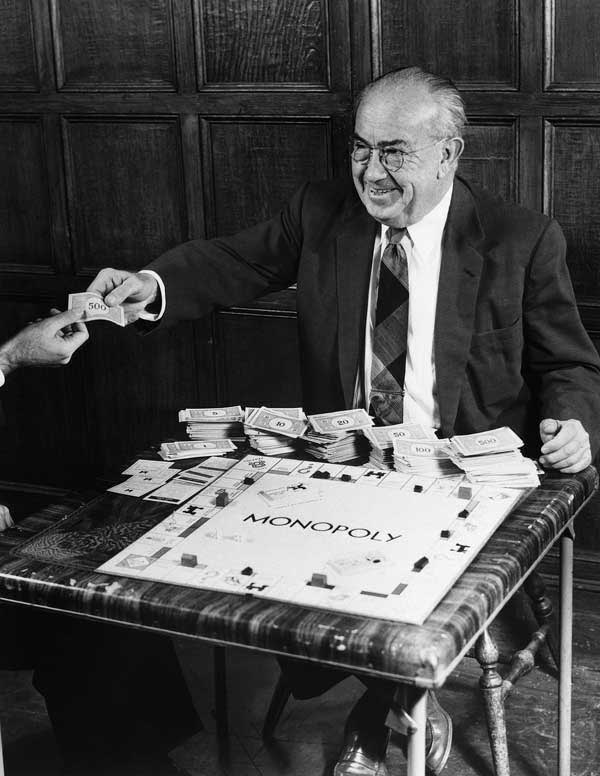
Charles Darrow. This name may be unfamiliar, but he most likely had an impact on the childhoods of many with a wildly successful and influential creation. A board game recognized throughout the world for more than 70 years, Monopoly is a game that provokes intrigue and interest from a wide variety of age groups. Within a year of Monopoly’s introduction in 1934, it had become the most popular game in America. Since then, Monopoly has evolved to encompass a vast number of products and to create a tremendous legacy.
During the Great Depression, Charles Darrow, a native of Germantown, Pennsylvania, was a struggling salesman, seeking work to support his family. He tried to work at various job sites, but all of his opportunities were temporary. One evening, Charles Todd, a businessman and friend in the area, introduced Darrow to a board game entitled “The Landlord’s Game.”
Designed by Elizabeth J. Magie Phillips in 1907, “The Landlord’s Game,” was a patented board game in which property values and rent collection were the key components for players. According to Magie Phillips, “I conceived the game of Landlord to interest people in the single-tax plan of the great economist, Henry George.” However, “The Landlord’s Game” did not have the appeal or the funding necessary to enter a somewhat disinterested market, never truly making an impact. “The Landlord’s Game” did not seem to have the appeal or funding necessary to succeed in the games market—but with the use of a creative approach, Darrow was able to evolve the original concept into his own game thirty years later.
Although Darrow lacked the means to properly market his creation, Monopoly received positive feedback from friends and family, and Darrow remained determined to get his project off the ground. He acquired a patent in 1933, and began selling hand-made Monopoly board games. His precision and deliberateness, though, only allowed for one or two sets to be produced each day. According to Rod Kennedy and Jim Waltzer, in Monopoly: The Story Behind the World’s Best-Selling Game, “Darrow fashioned a circular board game and created the other elements by hand, coloring the oilcloth, typing deeds and cards, and cutting “houses” and “hotels” from wood molding.” Playing pieces also included colored buttons and a variety of other household items, showing evidence of his determination and vision.
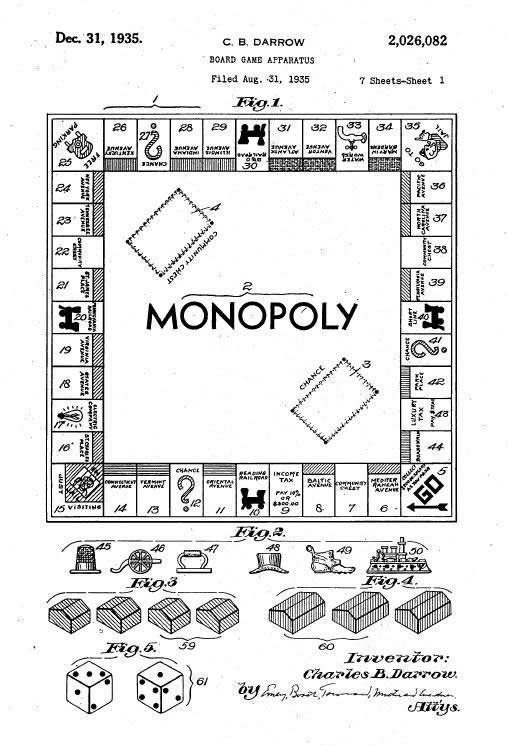
Darrow frequently referenced his childhood family vacation spot Atlantic City, New Jersey when naming streets, properties, and railroads for the game. A commemorative sign currently located in Atlantic City reads, “[Darrow] labeled [Monopoly’s] streets after avenues along the Boardwalk… and gave new meaning to the word ‘gaming’ in Atlantic City.” Darrow was enamored with the board game and the possibility of success while playing, since wealth and prosperity were largely absent for most people in the Depression era.
Darrow first attempted to contact Parker Brothers to produce the game in 1933, but the company was uninterested in taking on the game’s production, citing fifty-two fundamental errors. Maxine Brady reports that Parker Brothers felt that the game was too long and complicated for its customers to play, and that it did not have a specific goal for completing the game as the company’s other games did. However, Darrow did not waver. As Jim Waltzer puts it: “Undaunted by the rejection, [Darrow] took the next step on his own, printing copies and selling them through local department stores and the New York-based toy company FAO Schwartz.” Darrow quickly found local success and hired printer Lytton Patterson Jr. to help produce the game. Patterson automated the process by “printing the black lines and words on large squares of oil cloth,” as Tim Walsh put it in Timeless Toys. The two used any material necessary—including necktie boxes and molding scraps—to create the final product.
In the spring of 1934, Darrow hired an artist to design graphics. With icons like the first “Monopoly Man,” this artist was able to give the board game the look it needed for a positive public response. Colors, graphics, and new game characters, including the infamous Jailer, were added for an extra flair. Game pieces were reshaped and letters bolded for a sleeker, cleaner design. These changes were critical in helping the product to succeed initially, especially in the local market. It allowed Monopoly to gain the exposure it needed and eventually regain the attention of Parker Brothers.
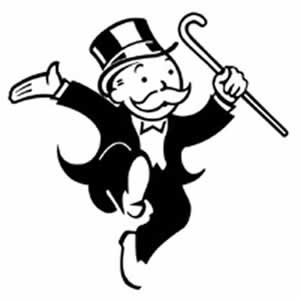
After Patterson printed 500 sets, Darrow contacted a Wanamaker’s Department Store in Philadelphia, to convince a buyer to carry his board game for the Christmas season. The buyer was persuaded after receiving numerous recommendations, and stocked Monopoly for its busiest time of the year. During the holiday, the game received an overwhelmingly positive response from customers. Darrow’s approach had proved to be profitable, with more than 5,000 hand-made sets sold. Darrow, however, found it increasingly difficult to meet with the demands of running a small business and managing re-orders from the leading retailers of the game industry in Philadelphia: Gimbel’s, Macy’s, Marshall Field’s, and Wanamaker’s. Phillip Orbanes writes in his book Monopoly that “he had to worry about purchasing materials, having game boards and boxes fabricated, arranging for trucks to deliver his goods, typing invoices, arguing over terms of payment and packing requirements, collecting his money, and paying taxes.” It was difficult for Darrow to meet the demands of the local stores, but he was pleased and grateful for the success of his product.
Charles Darrow’s perceptiveness allowed him to recognize a significant chance for an opportunity during the most difficult times. The average person could not afford to go out and spend money on entertainment, and Darrow recognized the prospect for creating an interesting and inexpensive type of household amusement. His board game allowed for people to take their mind off financial problems and stress. During a period in which profitability was at a minimum, Monopoly helped to create a glimmer of hope in the gloom of the Great Depression.
In 1935, after becoming aware of Monopoly’s success in the local Philadelphia area, Parker Brothers reconsidered their original assessment and invited Darrow to New York for a conference. Parker Brothers’ interest now lay in Monopoly’s new graphics and board. As Phillip Orbanes writes in Monopoly, “His appealing design had caused the firm to change its answer from no to yes.” Darrow, eager to be rid of the pressure of running his own business, signed over his growing operation. After a day of deliberation, a deal was established and Parker Brothers was issued the license to distribute Monopoly as their product.

The deal quickly proved to be in both parties’ best interest. The game received praise and a growing amount of national attention, and, once patent difficulties with Mrs. Phillips were addressed, Parker Brothers sold 250,000 copies within one year. According to Tim Walsh, board game inventor and designer, “The Depression had nearly devastated Parker Brothers and by many accounts, Monopoly saved the 52-year-old game firm from financial ruin.” At the age of 46, Charles Darrow retired and continued to receive royalties for the rest of his life. Though once struggling to get by on a daily basis, Charles Darrow was now a millionaire.
Charles Darrow’s story is one of triumph and accomplishment. His invention changed how the world perceived the gaming industry, becoming the most recognized and played board game in history. According to Phillip Orbanes, senior vice President of research and development at Parker Brothers, “Darrow gave Monopoly their first visual signature. His artist stylized the corners of the board…and created the first copyrightable look that all of America has come to know, the look that represents the game of Monopoly.” Darrow’s legacy is one that demonstrates an ability to overcome the most difficult times, and to succeed through creativity and determination.
Monopoly’s legacy, however, is perhaps even more remarkable than its creator. Currently sold in 107 countries and in 37 different languages, Monopoly has grown to become the world’s best-selling board game, having a tremendous impact on various cultures worldwide. Over the course of the game’s history, Monopoly has evolved and become quite expansive from its original game contents. Today, Charles Darrow would be amazed with the diversity of Monopoly brand products, and the wide variety of ‘customized editions’ developed for major cities, universities, sports teams, and music icons, among many others. The Monopoly brand has produced electronic sets, with automatic banking features, as well as ‘mini’ board games for traveling purposes.
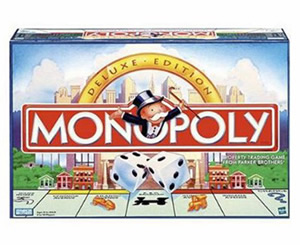
Enjoying the game with friends and family, though, is not the only option for players today. Monopoly tournaments on the Internet as well as in many locations around the world have allowed for avid players to increase their skill in a competitive environment and parallel their strategies in the business world. An excellent example of the phenomenon is Patrick Wee, the 2009 Singapore National Monopoly Champion, who began playing the game at a young age, and whose drive to compete evolved over time. Mr. Wee divulged how the game related to his interests and helped him to develop strategic thinking abilities in his own profession:
I don’t know whether I got involved in real estate because of Monopoly but I definitely draw some parallels between investing in real estate and being good at the game. Property investment is about converting raw land into valuable property. Similarly, in Monopoly, I have to buy land and turn it into houses and hotels to become the richest guy.
This is not the only example of players using Monopoly strategy and incorporating it into real-life decision making processes. In a book written by Alan Axelrod, discussing the nature of business and how Monopoly can relate, he states, “I am hardly alone in the belief that games in general and Monopoly in particular model business…Once it was firmly lodged in my own mind, the notion of holding up to business the mirror of Monopoly suddenly seemed to be everywhere.”
As Monopoly strives to compete in its own competitive gaming market, unique Monopoly editions and adaptations have allowed the game to become more advanced and creative, giving it the ability to attract and cater to many different audiences. The adaptations help players relate directly to the game they are playing, which provides greater enjoyment and entertainment. A few of the customized Monopoly editions include the Beatles Monopoly Game, Philadelphia Phillies World Series Monopoly, Pittsburgh Steelers Super Bowl XLIII Monopoly, and Penn State-Opoly.
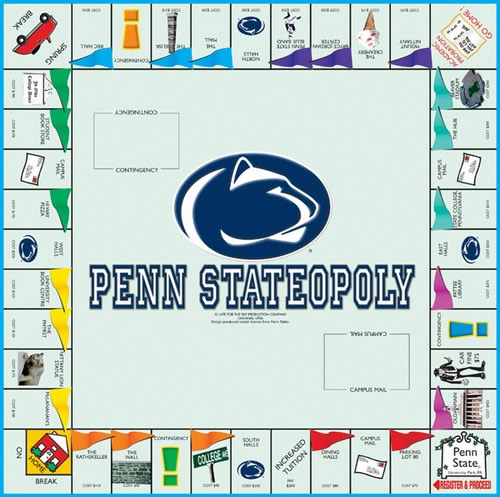
Penn State-Opoly, for example, allows for students and alumni alike to “own” their favorite downtown properties, including the State College Diner, home of the famous Grilled Sticky, or The Phyrst, a treasured local dive bar. The Penn State adaptation provides a sense of nostalgia for the loyal alumni who hope to relive their college days in Happy Valley. According to Charles E. Ohanesian, a distributor of the product, “Research shows the Penn State alumni are very loyal to their alma mater, and very supportive of it.” And Penn State is not the only school with their own Monopoly board game. Other schools in the Big Ten, as well as schools in other conferences, such as The Big 12, SEC, and ACC also have Monopoly games that represent their scholastic pride.
Commemorating sports franchises and major events, such as the World Series and Super Bowl, has created tremendous success for the Monopoly brand. The sports adaptations include star players and pictures from the season for the devoted fan. Specifically, the Pittsburgh Steelers Super Bowl XLIII Monopoly includes players Ben Roethlisberger, Willie Parker, and wide receiver Santonio Holmes—major factors in their 2009 Championship. Even the game pieces, which include a Steelers helmet and a Rams helmet, bring the board game to life. The sports commemoration theme is also demonstrated in a Monopoly tribute to the Philadelphia Phillies World Series Championship in 2008. The board game includes key players Ryan Howard, Shane Victorino, and pitcher Cole Hamels. Philadelphia Phillies fans can enjoy the most memorable events of the season by using game pieces, such as the World Series Trophy, a baseball glove, and a batting helmet. In creating the numerous adaptations, Monopoly shows it understands the importance of change and creativity in order to maintain the brand.
Recently, new developments have given Monopoly even more exposure in the market. In 2009, Hasbro CEO Brian Goldner discussed the possibility of bringing the Monopoly board game to the Hollywood big screen. In an interview, Goldner stated, “The great part about Monopoly is the history, literally the history of the creation of the brand and the fact that the brand is 75 years old. So you have this great opportunity for the real history as well as the fictional history to tell stories of families and characters.” The movie will discuss everyday occurrences and take an interesting approach at discussing today’s business environment and financial markets, incorporating Monopoly references and strategy.

Also in 2009, Monopoly unveiled a new internet version called CityStreets, an adaptation in which GoogleMaps is used to find property across the globe. Essentially, all streets found through GoogleMaps can be seen as real estate opportunities. A street’s value is based on its length as well as its location in a particular city. A street located closer to certain landmarks, or in more prominent areas, will greatly increase its value. The virtual game encourages players to purchase property that will eventually build an empire, while ultimately sabotaging other players’ property endeavors in the process. According to Donetta Allen, a spokeswoman for Hasbro, Monopoly is looking for innovation, “We’re trying to show that board games are contemporary. This is a fun and unusual way to introduce the game to a new generation.” These examples reinforce Monopoly’s dedication to improving its brand in order to accommodate more advanced customers and technologies.
Since its humble beginnings in Germantown, Monopoly has expanded to become a staple in households worldwide. Charles Darrow invented a unique product, and the game has continued to take on many new forms and draw new players to a timeless classic. Monopoly has made a profound legacy on the gaming industry, and those who have taken over for Darrow continue to maintain its position with inventive and dynamic initiatives.
Sources:
- Akkad, Omar El. “From Boardwalk to Beijing- and everywhere in between” The Globe and Mail (Canada) 9 Sep. 2009: B1.
- Axelrod, Alan. Everything I Know About Business I Learned from Monopoly. Philadelphia: Running Press Book Publishers, 2004.
- Bartholomew, Douglas. “The Curious Origin of the Game Monopoly.” New York Magazine 4 Dec 1978: 134-142.
- Billington, Alex. “Ridley Scott’s Monopoly Movie Hoping to Be Ready by 2012?.” Latest News. FirstShowing, 2 Mar 2010. 21 Apr. 2010 <http://www.firstshowing.net/2010/ridley-scotts-monopoly-movie-aiming-to-....
- Brady, Maxine. The Monopoly Book: Strategy and Tactics. New York: D. McKay, 1974.
- Bruce, Scott. It Happened in Philadelphia. Guilford, CT: Morris Book Publishing, 2008.
- Cazzoli, Frank. “Firms vie for Monopoly on Penn State Game.” Patriot-News (Harrisburg, PA) 7 Sep. 1987: A8.
- “Display Ad 283 -- No Title.” New York Times 13 Dec. 1953: SM67.
- Kennedy Jr., Rod and Jim Waltzer. Monopoly: The Story Behind the World’s Best- Selling Game. 1st ed. Layton, UT: Gibbs Smith, 2004.
- Monopoly- History & Fun Facts. Monopoly: The World’s Favorite Family Game Brand. 2008. Hasbro. 24 Feb. 2010 <http://www.hasbro.com/monopoly/en_US/>
- Orbanes, Phillip. Monopoly: The World’s Most Famous Game—And How It Got That Way. Cambridge, MA: Da Capo Press, 2006.
- Orbanes, Phillip. The Game Makers: the story of Parker Brothers from Tiddledy Winks to Trivial Pursuit. Boston, MA: Harvard Business School Publishing Corporation, 2004.
- The 30s, The Depression, and History-making Game. Who Invented Monopoly? 1985. Parker Brothers, 24 Feb 2010. <http://www.adena.com/ADENA/mo/>.
- Walsh, Tim. “Monopoly: America’s Favorite Playground.” Timeless Toys: Classic Toys and the Playmakers Who Created Them. Kansas City, MO: Andrew McMeel Publishing, 2005. 43-56.
- Zachariah, Natasha Ann. “Realtor Wins Monopoly Title; Mr. Patrick Wee Sees Parallels Between the Game and His Job in Property Dealing.” Straits Times (Singapore) 8 Apr. 2009: np.
